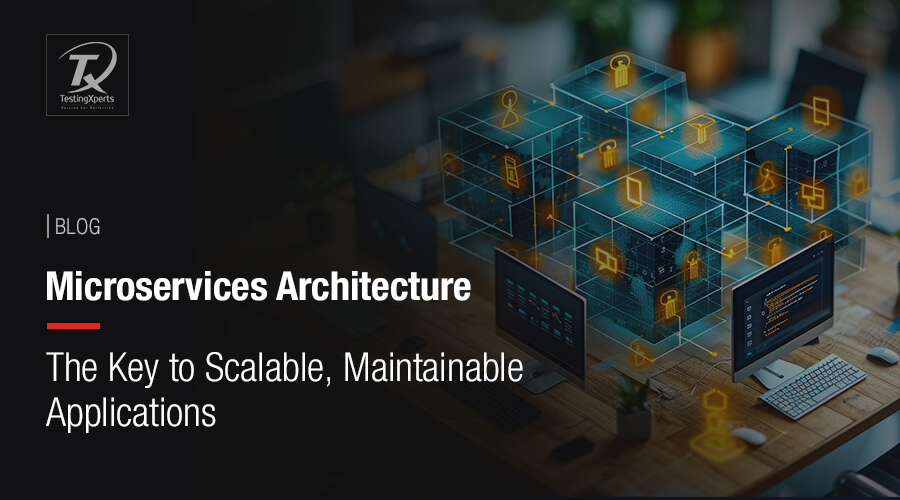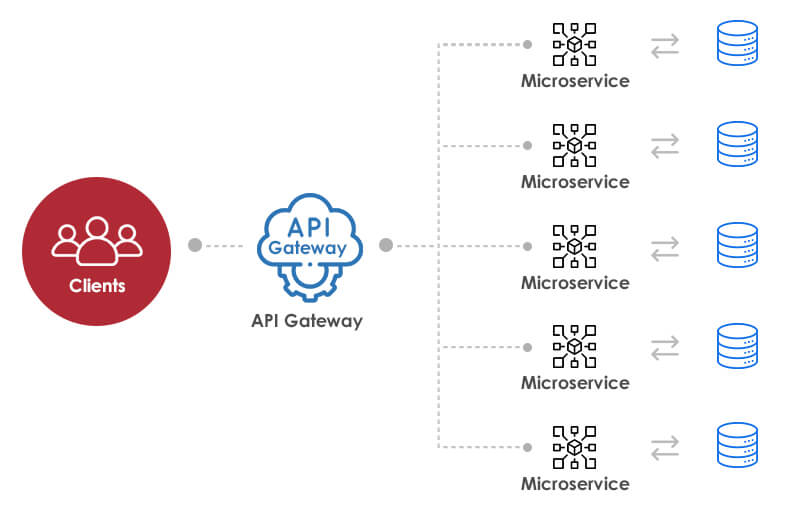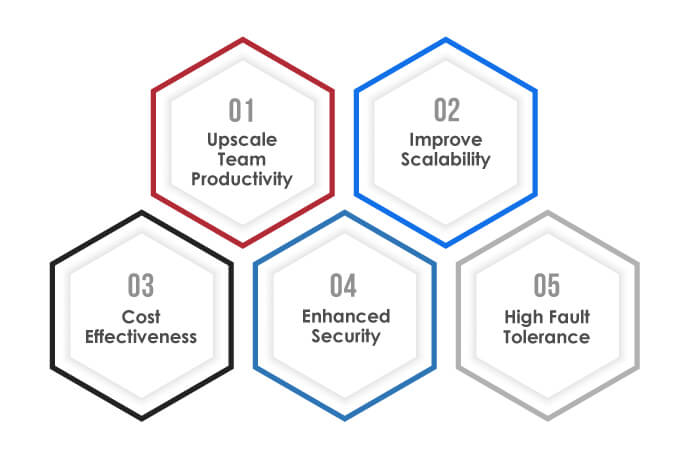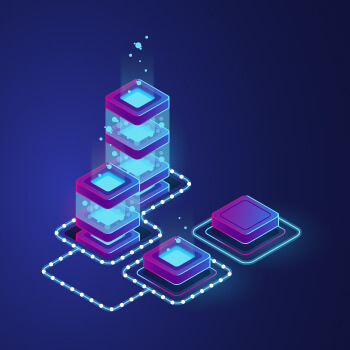
Have you wondered how brands like Netflix, Amazon, and Uber perfectly manage their huge data and user requests? The answer lies in implementing microservices, which allows them to grow rapidly and launch new updates without downgrading their systems. Businesses have been developing systems and applications for many years and are constantly improving the process.
During this journey, many architectural patterns, tech innovations, and best practices have come to light, and microservices are one of them. Microservices architecture involves continuous delivery, scalable systems, domain-driven design, infrastructure automation, and addressing monolithic structure limitations by breaking app development into smaller segments.
Digital services are dynamic-natured, so they must swiftly adapt to changing market demands. Microservices architecture facilitates flexibility, allowing businesses to develop, deploy, and scale services independently. It also enables them to release new features quickly, reduce conflict dependency, and streamline updates.
What is Microservices Architecture?
‘Single Responsibility Principle,’ a term by Robert C. Martin, states, “collect the things that change for the same reason and separate the things that change for different reasons.”
Microservices architecture follows the same approach, supporting loosely coupled services that can be developed, released, and managed independently. These services are responsible for their unique tasks and can communicate with each other via APIs to solve complex and larger business problems.
Containers are an example of microservices, allowing businesses to stay focused on service development and ignore dependencies. Modern cloud-native apps are built as microservices using containers. Enterprises utilize microservices to speed up the software/application development process. Let’s take a quick look at some of the uses of microservices architecture:
- To provide cloud support for existing data processing services.
- Separating ordering and payment processing makes them independent units, enabling payment processing even if invoicing has malfunctioned.
- Migrating a complex website hosted by the monolithic platform to a cloud-based microservices platform.
Now the question is, how does microservices architecture work?
(in below diagram, for Microservices, last layer is incorrect) //Changed
The microservices architecture segregates monolithic applications into a group of loosely coupled services, each focusing on a particular domain or business capability. These services communicate via well-defined APIs using lightweight protocols like RESTful, or centralized API gateways. Then, the containers, like Docker, pack and release these microservices by utilizing orchestration tools, such as Kubernetes.

Such a decentralized approach allows different teams to develop and independently maintain the application using the technologies and programming languages with which they are more comfortable. Microservices also optimize fault tolerance capacity by leveraging techniques like retries, monitoring/logging of issue detection, circuit breakers, and distributed tracing.
Benefits of Microservices Architecture

Microservices architecture offers various benefits and takes modern app development and maintenance procedures to the next level. It breaks complex apps into smaller, manageable services, enabling them to operate independently. This gives enterprises the following benefits:
Upscale Team Productivity
Teams can focus on service development, release, and maintenance tasks without getting burdened by system complexities. Every member will have their own tasks based on their expertise, leading to more informed decisions, quick iteration, and quality services within the particular domain.
Improve Scalability
Thanks to each service operating independently within a microservices architecture, DevOps teams can implement new components, technology or language without worrying about downtime and compatibility issues. They can even mitigate the performance impact of each component by deploying services across multiple servers and allowing their organizations to avoid vendor lock-in issues.
Cost Effectiveness
It helps optimize resource allocation and service maintenance as teams work on a well-defined and small number of services. Businesses can reduce overall development and system maintenance costs by localizing their efforts to each service. Teams can focus on specific functionality and ensure resources are efficiently utilized.
Enhanced Security
Breaking services into smaller parts reduces the application’s attack surface. Even if a security breach happens in one microservice, it will not compromise the entire system. Businesses can also implement security policies specific to each service risk factor.
High Fault Tolerance
By breaking services into microservices, businesses can ensure that one service failure doesn’t affect the other. Also known as fault isolation, this leads to higher app availability and less downtime, crucial for ensuring user trust and satisfaction.
When to Use Microservices Architecture?

Microservices architecture has changed how modern apps are developed and managed, offering various business benefits. But the question is, “When should you go for it?” Here’s the list of reasons for using microservices architectures:
- Support monolithic app migration to improve agility, delivery speed, scalability, and manageability.
- Modernize legacy apps by restructuring modules/functions to microservices.
- Reuse independent business apps and services across multiple channels, such as payment services, customer support services, time tracking apps, notification support, etc.
- To make infrastructure and computing resources management available to the resources as per requirement.
- Rewrite legacy app code to modern languages and technology stack to align with modern business practices.
- Upscale backend service to facilitate client-web app response where data comes from different sources.
These were just a few of the scenarios that would require microservices architecture. There could be others. The company must define an architecture that structures its app as loosely coupled yet collaborating services.
Challenges of Using Microservices Architecture

Although microservices offer numerous benefits, they also have a set of challenges that need attention. Here’s the list of common challenges that businesses may encounter when implementing microservices architecture for handling distributed systems:
Increased Complexity
Moving from monolithic to microservices increases the system’s complexity. Developers must manage multiple services, each with databases, configurations, and dependencies. This requires sophisticated service discovery mechanisms, complicating overall system design and management.
Communication Challenge
Microservices architecture relies heavily on inter-service communication, which becomes complex as services increase. Each service will have its own API and protocols, making the communication process challenging. This challenge can be handled by adopting communication patterns like REST and event-driven architecture/
Distributed Monitoring and Tracing
Monitoring and debugging microservices apps is a hectic process involving multiple services. Traditional monitoring tools are not suitable for this. One way to handle this problem is by integrating distributed tracing systems to track requests across services. Another way is utilizing centralized logging and monitoring mechanisms to analyze metrics from various services.
Testing Challenges
Compared to monolithic architectures, conducting testing in microservices architectures is more complex. It involves individually testing each microservice and their interactions. This requires comprehensive integration and E2E testing strategies, which increases the time and resources required.
DevOps and Deployment Challenge
Microservices deployment involves handling multiple service instances and their compatibility across different environments. This makes it challenging for organizations to release microservices using traditional methods.
Why Choose Tx for Your Microservices Architecture Needs?

Selecting the right partner to enhance or transition to a microservices architecture. Tx is one of the leading digital engineering services providers, offering comprehensive services to help you implement one. Our capabilities in this field include:
Helping You Design and Implement Microservices
We assist you in designing and implementing a microservices architecture, breaking down apps into smaller, independent services for easier management, faster deployment, and scalability.
Advanced Integration Solutions
To handle complex integration challenges, we offer seamless solutions to simplify the interconnection of various microservices and APIs. This includes implementing RabbitMQ and Kafka for asynchronous communication and improving app performance.
Robust Data Management
We implement strategies like event sourcing and CQRS to maintain data integrity and consistency across distributed services. We define clear boundaries for each microservice and use event-driven architecture.
Summary
Microservices architecture upscales app development by transforming complex applications into smaller, interconnected services. This approach optimizes system resilience and enhances flexibility, thus facilitating rapid deployment and independent scaling of services. It is a strategic step for businesses aiming to improve their applications and manageability across various sectors. To know how Tx can assist with implementing a microservices architecture, contact our experts now.
Discover more
Get in Touch
Stay Updated
Subscribe for more info


